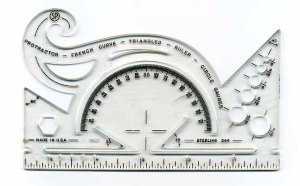This is a good mantra…and maybe it should be something you recite to yourself as you move around your day, involve yourself in all kinds of tasks, and show others that everything you get involved in has a “learning component”.
There are few things in life that I do from which I cannot take something of value from the experience. Learn something new, or have a deeper understanding of something… Even reinforce past knowledge by setting the stage to learn even more in the future.
It’s like my brain is a sponge constantly soaking it up! Can you identify an example of learning something new and it becoming the way you choose to do something even today?

I remember something my dad taught me at a young age, you know, back during the day when you were too small to do the task but you watched. It was in tightening the lug nuts on a wheel. Criss-cross pattern. Making a star. Go around the lug nuts and tighten repeatedly in this pattern to ensure that the wheel is equally tightened.
I am sure this was one of my early remembrances of things done with patterns. From then till now I look for and see patterns in the most innocuous things. Look at a planted field from one angle and it makes no sense. Move a few inches and look again then you will find a pattern. Drive quickly down the road and watch that pattern flit and fly! Flip the pages of a book and watch for empty space between words and sentences…do it long enough and you’ll see patterns emerge.
If we look hard enough we will find a pattern to just about everything and anything. If we work hard enough we can follow established patterns to solutions. In fact, most of our learning comes from patterns that fit our style of learning!
Carry it a step further. We make something from patterns someone else has already defined, thus we create aesthetically pleasing art, set up a musical score, or even develop computer programs and apps. Most of what we do comes from some pattern previously established!
Consider this. At which grade did I first take this French Curve Protractor to school? No idea. (Where did it get its name? Again. No idea!) But with a simple tool, we can take established patterns and combine them into a new look. I remember sitting in class, whiling away the hours, creating and drawing new designs based on this simple tool. I did not have to understand the words on the face of the protractor, no, I simply used it as a tool. Circles. Curves. Angles. Straight lines. Corners. There was even a bulls-eye to center the tool on the drawing surface!
Later in life, I picked up a different, but similar, tool that stayed with me for my future career of IT (Information Technology, back then it was DP – Data Processing). Before I consciously turned my attention to programming, a flow chart was an important piece of documentation to follow the logic flow of daily processing.

When programming I used many different flowcharting tools from a template much like this one from IBM. Yes. I still own them, all 6 of them! (Big, small, and even in another language!) With established patterns that mean something, I could flowchart logic and layout the idea of a solution that a programmer would code from. We even used them to document processing flow for finished applications.
Whether creating the flow chart, or following the flow, you understand better what is happening because there is logic documented, stored, shared, and used when problems arise. I even have metal rulers that contain all the flow-charting symbols so it was easy to pick the tool required depending on the circumstances. Yep. I still have them. All 3 of them!
How did these tools help?
The concept of logical flow met the way my brain works throughout much of life! I love to see the results of logic. In many ways it’s predictable. Illogical ways of thinking and doing are not me!
They allowed me to use my intelligence in thinking the process through before beginning coding or identifying a problem, at the same time the results either made sense or showed areas where the flow needed to be tweaked.
After the fact, these charts are updated as the processing changed. Think about it. The symbol for a punched out card deck (keypunch cards) later became a Tape or Disk file, thus the process and program changed to reflect the growth of technology. Add a processing step? Update the flowchart. Ditto when you removed or redesigned the processing flow! Move into the cloud? Yep. There’s a logical flowcharting tool to reference that process!
This was part of our documentation. It could be laborious to create, angst-driven to be updated, and it wasn’t always fun, but it sure helped in times of emergency to follow the logic trail to ensure we were correctly processing data.
Remember the old adage, GIGO – Garbage In, Garbage Out! As you updated files you noted spots where backups were needed in case you had to back up a few steps and start all over. You surely did not want to process new input on datasets that were not the correct one!
Programming is simply processing data from start to end! There may be some complex code to manipulate the individual bits, bytes and files. There may be some complex logic behind the scenes of calculating for results! Your math skills may be tested! But all you are trying to do is process data. Logically.
Here’s another word used in the flow-charting process, and in fact, every flowchart contained them. They are decision trees or decision points. They identify the questions need to be asked to determine which way to go in processing.
Think about entering a date on some new application you get on your smartphone. The program makes decisions about the data you input to determine if it’s numeric or alphabetic. First question? Gregorian or Julian? Which field gets entered first? Month, Day, Year? Or, do you use the Military version of Day, Month, Year? Must the date follow the format of MMDDYYYY, or can you simply do it like we did last century – MMDDYY? Does the month fall within the set parameters of 01-12, or January through December (spelled right?)? Do the days only fall within the number set of 01-31, and then which month can only have 28, 29, 30, or 31 days? Is it a leap year? Is the year a proper year? (Is anyone alive have a birth year from the 1800’s?)
All questions must be asked, and decisions of what to do when the answers are outside of the parameters. It’s a learning process! It helps to learn how to ask better questions!
Okay. Once developed, it can simply be a called or shared routine that is used by multiple programs, but someone had to initially program the patterns, ask the questions and respond appropriately.
Patterns often make it easier for us to see the logic, and this logical flow makes it easier for us to learn from the patterns.
If we would only look for these patterns to learn how to live!
Here’s my thought today. What patterns did you follow that produced the person you are today? From your dress to your diet, from your speech to your thoughts, from your preferences to your actions. Somewhere in your past, there was a pattern you followed that turned you into the person you are!
In fact, these tools and lessons learned in an earlier life help me as I age to consider the possibilities before me and help me make better choices for steps into the future!
The Apostle Paul wrote to his protege, Timothy, one last letter that contained instructions for living, as well as a pattern to continue walking in as he lived his own future.
Hold fast the pattern of sound words
which you have heard from me,
in faith and love
which are in Christ Jesus.
(2 Timothy 1:13 NKJV)
(emphasis mine)
Break the sentence down to smaller sets of comprehension. Isn’t this how we comprehend the speech pattern? Some translator sure did!
In other words, Paul is helping Timothy learn to live his life forward by utilizing the examples given to him (from Paul, by Jesus) and to replicate those examples by following them as a pattern.
Carry this a step further and you quickly realize that others will follow Timothy and thus the patterns and examples from Paul will spread into the future! Even to those of us who read and follow Paul’s writing today!
What happens when we cut loose from our taught patterns? I see it happening all the time. Patterns of others (cultures, life choices, politics, technology, etc.) are chosen and they merge and diverge like rabbit trails into new and different directions. Before long you cannot even tell where the original pattern originated.
Perhaps before we let loose of the old, we need to comprehend the direction of the new. It’s not just that we are making new choices, but they will be propagated into the future. How far out can you see the future? Our ways are proscribed by the patterns we chose to follow. Ditto with our ending.
When I thought deeply in order to understand this,
it was painful for me,
until I went into the sanctuary of God;
then I understood their end.
(Psalms 73:16-17 MKJV)
Maybe the key for all of us should follow David’s thought. Keep the patterns of life taught by others, even look at some of the new options showing up, but take all them into our sacred place and comprehend their ending in light of God’s understanding. After all, we are here to please and serve Him, so we better be good at making logical choices that keep Him before us!
One last thought. Everything we attempt to do follows the pattern and logic of someone else, even the natural world. We learn this in geometry (check out this article) with phrases like Pi, Phi, Golden Ratio, and a host of other terms. Most everything that is symmetrical and orderly came from some pattern that existed long before you thought about them!
Seldom do we strike out on our own and simply do! We mostly follow others! Someone else in some far off past broke ground, learned something new and started us off a new pathway. Yes, there are a few Pathfinders (my old CB handle) that break open new territory, but for the most part, the majority of us simply follow an existing set of choices. The pattern for a good diet, marriage, career, or even when taking a trip has already been established!
Everything follows a pattern, uses logic, and contains decision trees! So. Pick the best plan forward, follow it, replicate and duplicate, and share with others! That's the ultimate of success! Share on XCan you identify the patterns you’ve chosen that define you? You may be an original you, but I’m sure you haven’t broken the mold and become something totally new. Go ahead. Think it through. What are your patterns saying about who you are?


